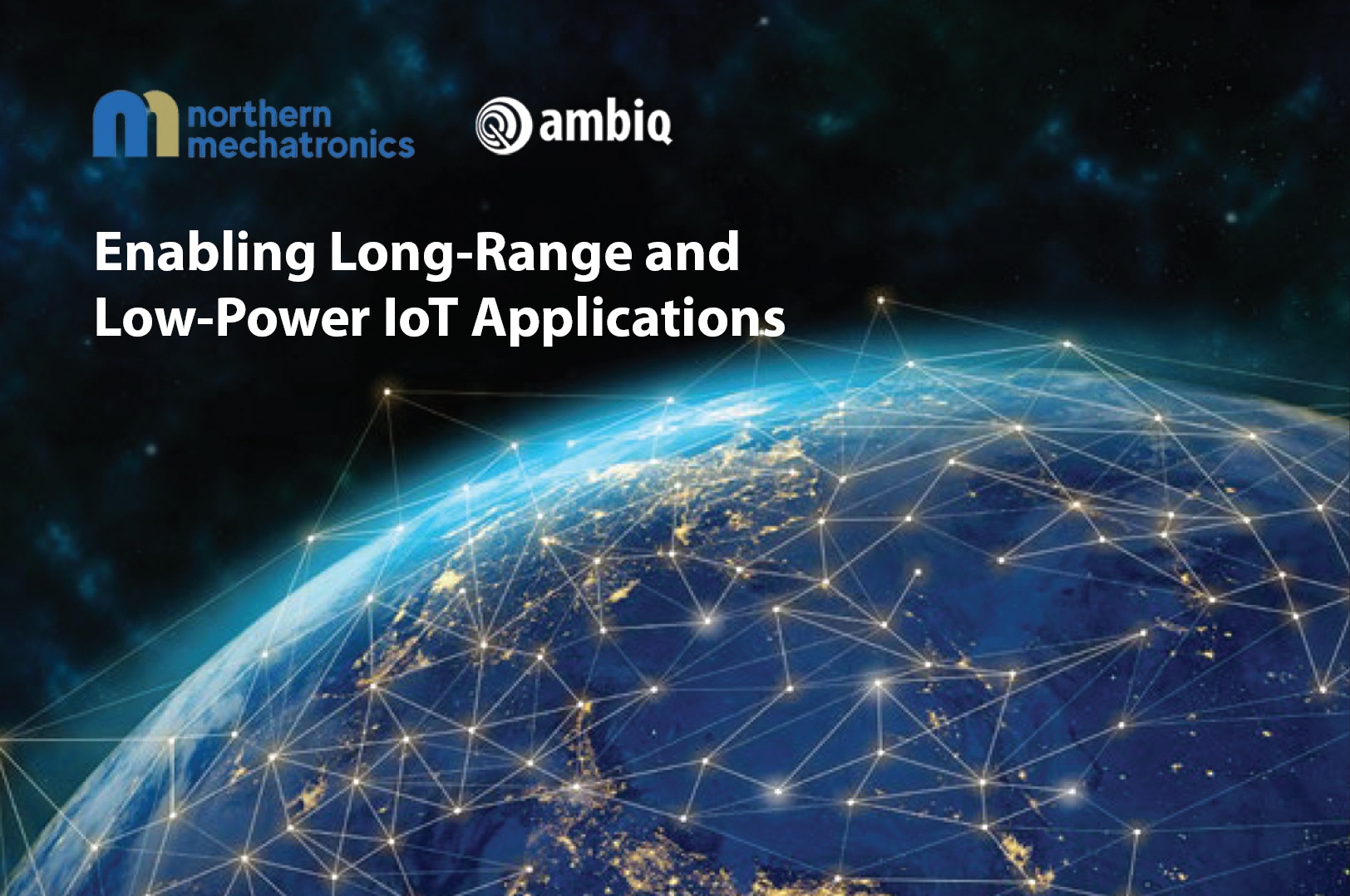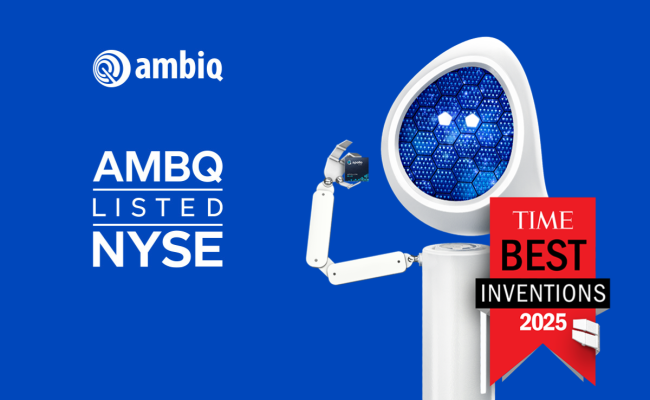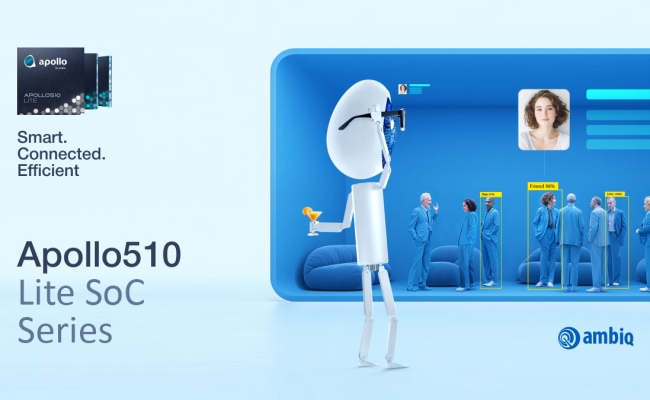New Industry White Paper from Ambiq and Northern Mechatronics Inc!

With the rapid expansion of the Internet of Things (IoT), digital sensors and networking technologies are increasingly utilized to connect devices and systems for more applications.
Many consumers are already used to IoT-enabled products such as smart speakers, smart doorbells, lighting and temperature controls, and security surveillance systems in a smart home.
The key technologies that enable IoT in consumer use cases and smart homes are wireless technologies such as Wi-Fi®, Bluetooth®, and the new 5G. Among all the available wireless protocols, the most popular and prevalent technologies are Bluetooth Low Energy and LoRa (Long Range).
The combination of Bluetooth Low Energy, which is intended for short-range networks, and LoRa, which is ideal for low-power wide-area networks, is a perfect solution for easy and secure deployment of today’s IoT applications.
How IoT Deployments Evolved
Traditionally, most IoT deployments occur close to a telecommunication infrastructure, usually located in a city or a town. There, IoT devices can connect to existing cellular networks using LTE-M or NB-IoT protocols. These protocols are low-bandwidth, low-power, low-cost, and ideal for connecting IoT devices to cellular networks. In addition, typical IoT-enabled products are powered by portable battery or by plugging into an AC wall outlet. This seems ideal in a traditional setting, however, IoT devices and sensors deployed in remote locations pose logistical challenges for both battery life and maintenance.
Remote IoT deployments are often inaccessible for field technicians, and there could be hundreds of deployed sensors in a factory, making it impractical to check each one manually.
To meet these demands, industry leaders have leveraged the latest wireless trends and technologies, such as Bluetooth Low Energy and LoRa. By blending these wireless communication technologies, they were able to deploy IoT applications in remote locations more efficiently at a cheaper cost, thereby creating new opportunities.
The Future of IoT
The future of IoT lies on the edge where sensor device-to-cloud wireless connectivity does not have to rely on city communication infrastructures. Increasingly, wireless networking technologies, such as Bluetooth Low Energy, are already a fundamental component of many IoT applications.
Thanks to Bluetooth Low Energy’s small footprint and energy-efficient architecture, it enables small wireless sensors and controls to operate on a battery charge for years on IoT networks. Unlike traditional wired devices, users can place Bluetooth Low Energy-enabled devices in nearly any location without worrying about physical accessibility, technical difficulty, or financial practicality. However, most Bluetooth Low Energy-based IoT applications rely on a mobile phone’s cellular connection as a gateway back to the cloud. If the cellular network is not reachable, LoRa technology is needed.
LoRa is a wireless transceiver and a modulation technique from Semtech that translates data into a RF signal to be sent and received over the air to enable a long-range communication link. LoRa wireless RF technology comes in handy for IoT applications across a low-power wide-area network (LPWAN). The LoRa modulation technology makes up the physical layer of LoRaWAN, a software protocol based on LoRa. Together, LoRa and LoRaWAN enable long-range connectivity for IoT devices across industrial applications.
Why Use LoRa and Bluetooth Low Energy Together?
Bluetooth Low Energy and LoRa complement each other’s strengths, making them ideal for a variety of applications. Until recently, Bluetooth Low Energy usage was limited to low throughput edge devices like beacons and wearables. However, the latest Bluetooth 5.0 can send large data files or stream audio without quickly draining your device battery. On the other hand, LoRa fulfills the need for low-cost and widely deployed sensors that need to send tiny data packets over a long distance.
Bluetooth Low Energy and LoRa are crucial requirements that make up a complete wireless solution for low-power IoT applications. Bluetooth Low Energy addresses low-power short-range connectivity, while LoRa addresses low-power long-range connectivity.
The other requirement is an ultra-low-power system on a chip unit (SoC). SoCs, such as the Ambiq Apollo3 Blue, can handle the low-power edge compute needed to support real-time applications. Together, these technologies enable reliable, secure, and energy efficient IoT deployments worldwide.
A Better IoT Solution
In this White Paper, written jointly by Ambiq and Northern Mechatronics, how enterprises can find a secure and cost-effective solution to deploy IoT remotely and reliably without relying on existing telecom infrastructure are discussed. It concludes that Northern Mechatronics’ NM180100 module leverages both Bluetooth Low Energy and LoRa, to offer a global IoT solution ideal for long-range and low-power applications.
The module has already secured design wins in mission-critical applications, such as industrial machine health monitoring, delivery lockbox, and livestock health monitoring. By combining the transmit power of LoRa with the processing power of Ambiq’s Apollo3 Blue, the NM180100 meets the ultra-low-power and edge computing requirements for remote deployment.
Essentially, Ambiq’s industry-leading processor technology is empowering Northern Mechatronic’s solution for many practical and vital IoT applications.
White Paper Highlights
This White Paper covers key topics about IoT and wireless communication technologies for IoT applications, including:
- The Evolution of IoT Deployments and Current Trends
- Why Traditional Wireless Communication Solutions Don’t Work
- The Benefits of Using LoRa and Bluetooth Low Energy
- IoT Use Cases for Bluetooth Low Energy and LoRa
- What to Look for in an OEM Partner For Your IoT Solution
Download Enabling Long-Range and Low-Power IoT Applications White Paper
For more information about Ambiq’s industry-leading microprocessor technology, visit ambiq.com. To learn more about NMI’s global IoT wireless modules, visit northernmechatronics.com.
Contact
Charlene Wan
VP of Branding, Marketing and Investor Relations
cwan@ambiq.com
+1.512.879.2850
Read Article in: Japanese | Simplified Chinese | Traditional Chinese

